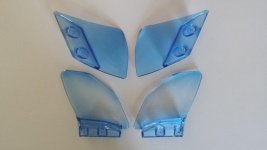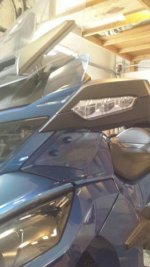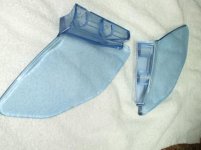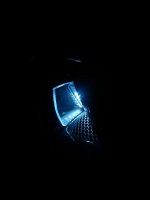Thanks for the thoughts, and yes, I did see the date, but had to start somewhere! I did this in my garage in a deep fryer, and chose to vertically suspend the four pieces I wanted to do, thus requiring quite a bit more water. I did also try doubling the dye quantity (64g) and increased the dwell time, just began to see a darkening, but only very slight. My research on methods did not turn up too many specifics on the proportions, but it did lead me to the Dyemore product and inclusion of acetone (5-10%) in the mix, so I'll see how that works. The acetone concerns me because of possible crazing, but in solution at that concentration is probably okay. Certainly having a piece to experiement with would be desireable. Yes, paints, films etc. are all alternatives, but I kinda like the dye method.
1/24/20 Update
I have now sucessfully tinted the wind deflectors on my '18 RT, here are the details:
Procedure:
- Remove the deflectors and hand wash each piece with a soft cloth in warm water and mild dish detergent. Suggestion: After washing and IF the deflectors are not brand-new, it is best to remove any surface oxidation or scratches. Any irregularities in the surface will affect how the dye deposits onto the surface; oxidation causes the dye to appear blotchy. To remove the oxidation, gently polish the surface with a clear plastic polish such as Meguiar’s PlastX™.
- Combine water, dye, and a small amount of dish detergent in a shallow pan, enough to fully cover the deflectors to be tinted. I used 5L of water, a full bottle of Rit DyeMore® Sapphire Blue dye (207mL), and one tablespoon of Dawn dish detergent. Bring the solution to a boil.
- Fully submerse one of more of the deflectors in the solution and maintain boiling for approximately 30 minutes.
- Remove the deflector from the solution and submerge in warm water to rinse any excess dye from the surface. Remove from rinse water and gently pat dry with a soft cloth and then hang to fully dry for several hours before touching the surface.
Commentary and Observations:
It became apparent that the existing condition and age of the deflectors seemed to have an effect of the final surface appearance after dying. My deflectors have been exposed to the elements for about one year or so since the unit was first uncrated. This means some minor oxidation and certainly several wash cycles have occurred during this period; this affected how the dye deposited on the surface.
Given the above conditions, I considered my deflectors to be in near perfect condition with no scratches and a very clear, smooth surface… or so it appeared. So, all I did was hand wash them before dying; I did not initially polish the deflectors as suggested in the procedure above. After dying I noticed the bottom two deflectors had a more uniform finish compared to the upper deflectors (flanking the windshield). I reasoned this to be because the upper two are more exposed to the sun (UV degradation) and cannot be washed as thoroughly as the bottom two, which have slightly less (direct) sun exposure (due to location) with both sides exposed for easy cleaning. (As noted above and below, I did also try the black power dye method, this could have also contributed to the blotchy appearance, but only two of the four deflectors had this undesirable appearance, so I think oxidation was more likely the problem.)
To improve the finish of the top two deflectors I then chose to polish the surface, with the initial intent of re-dying these two pieces. As polishing proceeded, I was able to remove the blotchy appearance, but I was also removing the dye and returning the plastic to a clear condition. (This certainly shows the dye is only penetrating a very thin top layer of the plastic.) As I stopped polishing to observe progress, I found I liked appearance (flat surfaces clear with perimeter edges still blue, see pictures), so I decided not to dye again.
The final result looks pretty good I think! (Kinda hard to tell in the picture with the deflectors mounted, but the bootm ones blend in and virtually disappear, which is what I wanted! Maybe the top ones could be re-done in grey or black.)
And one final note on the dye. I did initially try the black powder dye without much luck. I’m not saying this won’t work, I probably used too much water so the dye concentration may have been the cause. After some research into dying methods and agents I did discover this DyeMore® product from Rit (this is not an endorsement!). This dye is meant for synthetic fabric materials (the black power or liquid dye is for natural fibers), and certainly, the deflectors are not made of a natural fiber material! Those of you with different color rydes, Rit does make this dye in quite a few colors!
Happy motoring one and all!






